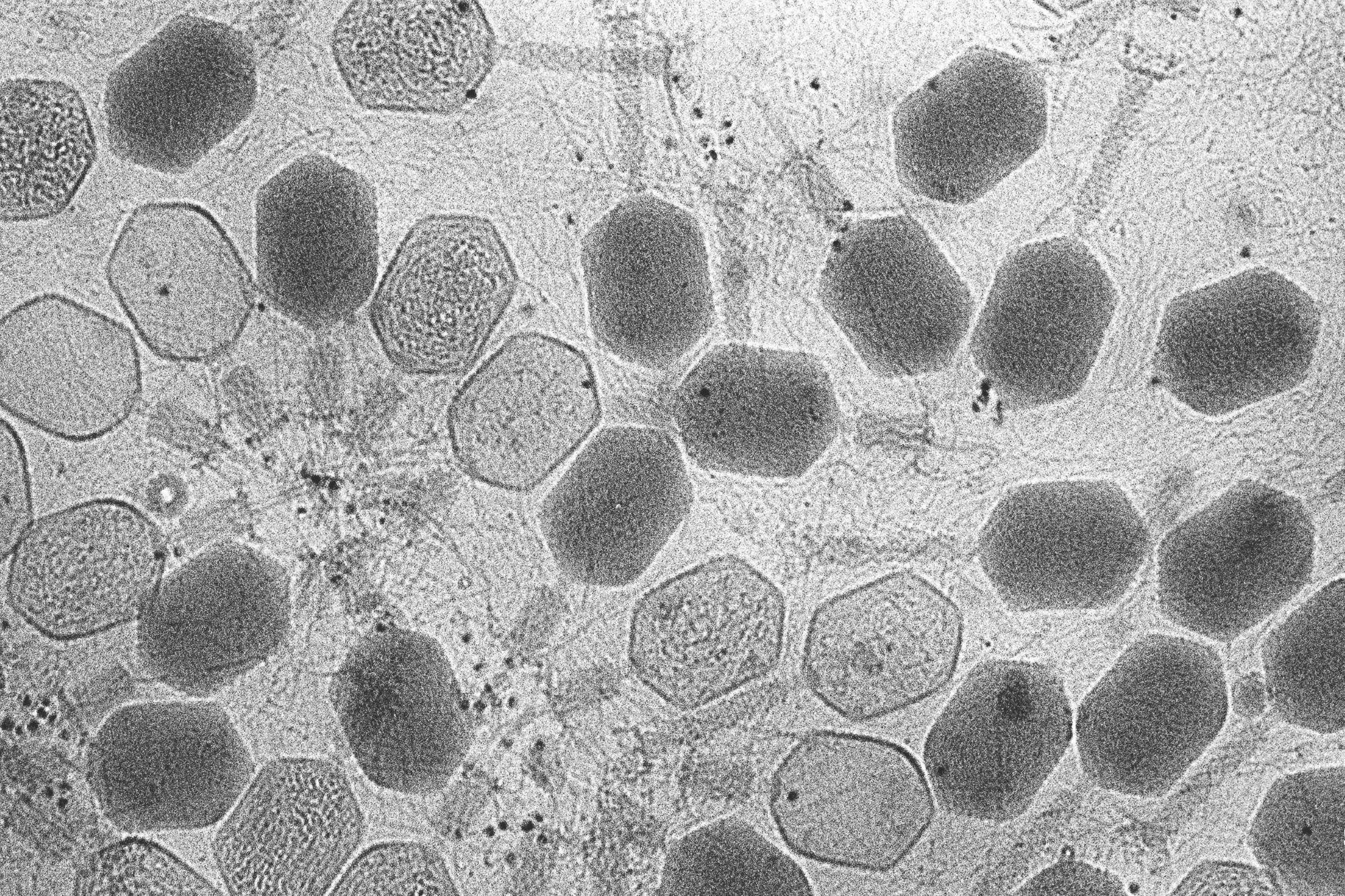Reviewed by Danielle Ellis, B.Sc.Jun 3 2022
CRISPR has made headlines in recent years for its potential to help patients with conditions as diverse as blindness and sickle cell disease. However, bacteria were already using CRISPR as an immune system to combat viruses long before humans adopted it to combat genetic disorders.
 A group of bacteriophages, viruses that infect bacteria, imaged using transmission electron microscopy. New research sheds light on how bacteria fight off these invaders without triggering an autoimmune response. Image Credit: ZEISS Microscopy, CC BY-NC-ND 2.0
A group of bacteriophages, viruses that infect bacteria, imaged using transmission electron microscopy. New research sheds light on how bacteria fight off these invaders without triggering an autoimmune response. Image Credit: ZEISS Microscopy, CC BY-NC-ND 2.0
CRISPR (Clustered Regularly Interspaced Short Palindromic Repeats) in bacteria steals small chunks of DNA from infecting viruses and stores them in the bacteria’s genes. These spacers are then imitated to form small tags, which adhere to proteins that float around till they locate a piece of DNA that matches. They recognize a match as a virus and cut it up when they find one.
Scientists from the Department of Physics and Astronomy of the University of Pennsylvania reveal that the risk of autoimmunity plays a major role in shaping how CRISPR stores viral information, determining how many spacers bacteria keep in their genes and how long those spacers are. The study was published in the journal Current Biology.
Spacers should presumably only match virus-specific DNA, but there is a small statistical chance that the spacer will also match DNA from the bacteria. An autoimmune reaction could result in death.
The adaptive immune system in vertebrates can produce autoimmune disorders. They’re very serious and dangerous, but people hadn’t really considered that carefully for bacteria.”
Vijay Balasubramanian, Study Principal Investigator and Cathy and Marc Lasry Professor, Physics, School of Arts & Sciences, University of Pennsylvania
It is possible that balancing this risk will place bacteria in an evolutionary bind. More spacers allow them to store more information and defend against more viruses, but it also increases the chance that one of the spacers will match the bacteria’s DNA and induce an autoimmune response.
Balasubramanian and co-authors Hanrong Chen of the Genome Institute of Singapore and Andreas Mayer of University College London discovered that bacteria could circumvent this by having longer spacers. A longer spacer will be less likely to match with the bacteria’s DNA, equivalent to how a lengthier password might be more difficult to crack.
This implies bacteria with relatively long spacers could have more spacers on the whole without evoking an autoimmune response.
The scientists used this concept to create a mathematical model that calculated the ratio between spacer length and the total number of spacers that the bacteria should still be able to store without triggering an autoimmune response.
They looked at the CRISPR DNA of thousands of species and compared the spacer length to the number of spacers preserved to see if their prediction held true in real bacteria after they developed the mathematical model.
The scientists discovered that the length of spacers and the number of spacers have a consistent and close relationship.
The surprise to me is that it matched so darn well just coming out of the box. This is a very simple theoretical framework. There’s a risk of autoimmunity, but it’s nice to have more immune memory, and you must balance these two considerations. It’s just very, very rare that something so simple matches the data.”
Vijay Balasubramanian, Study Principal Investigator and Cathy and Marc Lasry Professor, Physics, School of Arts & Sciences, University of Pennsylvania
According to Balasubramanian, the model’s success demonstrates that this framework of simple, mathematical trade-offs could be applied to more complex systems, like vertebrate immune systems, including humans.
Just by doing that statistical kind of reasoning you can make a lot of progress. So perhaps we can move back to vertebrate immunity and use the same techniques.”
Vijay Balasubramanian, Study Principal Investigator and Cathy and Marc Lasry Professor, Physics, School of Arts & Sciences, University of Pennsylvania
This is also one of the first studies to highlight the significance of the autoimmune response in bacteria. Future CRISPR studies, according to Balasubramanian and his collaborators, should take into account the risk of autoimmunity.
In terms of his group’s future projects, he wants to look into how CRISPR stores data in response to evolving viruses. Although a statistical model of evolving bacterial genes could seem far removed from everyday life, Balasubramanian claims that this research lays the groundwork for a better understanding of immunity, which could lead to a better understanding of viruses like the seasonal flu or new SARS-CoV-2 variants.
Balasubramanian adds, “These are all pieces of a larger puzzle.”
Source:
Journal reference:
Chen, H., et al. (2022) A scaling law in CRISPR repertoire sizes arises from the avoidance of autoimmunity. Current Biology. doi.org/10.1016/j.cub.2022.05.021.